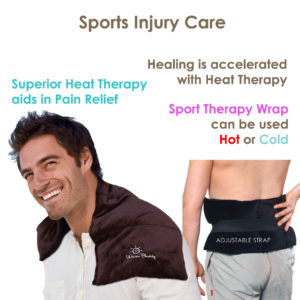Superior Heat Therapy for Sports Injury

To Heat or Ice an Injury? That is the Question
Americans encounter millions of injuries per year, with sports injuries alone accounting for around 8.6 million of them. Despite the prevalence of soft tissue injuries, many people wonder whether or not applying heat or cold products/ice to an affected area is best for recovery. The answer seems to depend on the type of injury that is causing you pain. According to specialists at Penn State Hershey Medical Center, the answer is simple. In the immediate aftermath of an injury, the RICER (Rest, Ice, Compression, Elevation, and Referral (seeking medical advice if the injury is severe or very painful). For stiff or painful muscles caused by everything from poor posture to stress, meanwhile, heat can be used in the moments leading up to activity.
Why is the RICER Method Key in the Immediate Aftermath of an Injury?
The RICER method for sprains and strains is useful because in the immediate aftermath of an injury, the body sends large volumes of blood to the injury site, resulting in inflammation, pain, and the formation of scar tissue. The application of ice alongside rest, elevation of the injured area, and compression, can stop blood from pooling in the affected area and help battle swelling and pain. If the injury is very painful or looks very swollen, referral to a doctor may be required to assess how serious the injury is. Doctors may recommend a scan so they can determine if there has been a fracture, for instance, or if the injury is only a sprain. They can also help you create a recovery plan you can follow in the days following the injury.
Heat for Muscle Tightness and Stiffness
When it comes to tight and stiff muscles, the opposite is true to the case of injuries. The aim is to encourage blood circulation and to loosen up tight tissue, which heat can help with. Dr. C. Onks of Penn State elaborates: “Heat typically brings blood flow to the area, which provides nutrients that the tissues need for healing. It can also increase the flexibility of tendons and muscles.” Heat also activates heat receptors at the site of an injury and flushes out injured debris from the site causing you pain.
Finally, it increases the healing rate by boosting the natural metabolic rate. In addition to hot water bottles, you can use items such as a Warming Pillow (ideal for tightness in the neck and shoulder area), a body wrap (which can be wrapped around the area causing you grief), and the Sport Therapy Wrap, which is conveniently weighted so it stays on areas such as your shoulders, neck, or legs while you are relaxing or working.
Both cold and heat can play an important role in recovery from injuries. In general, doctors recommend that the RICER method (involving the use of ice or cold therapy) be used right after the injury takes place. Heat can be used later to deal with muscular pain and stiffness, since it encourages blood flow and activates heat receptors.
Article Written By: Jennifer Ellen
